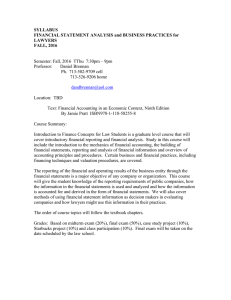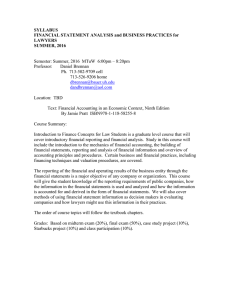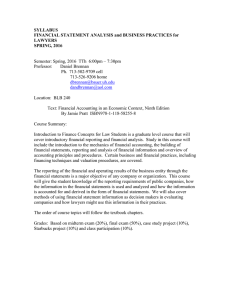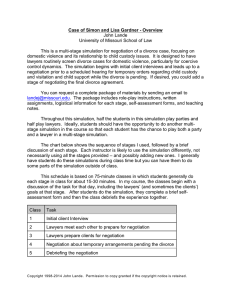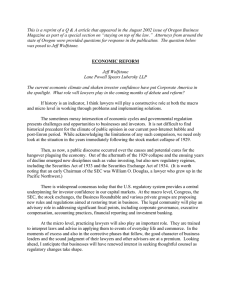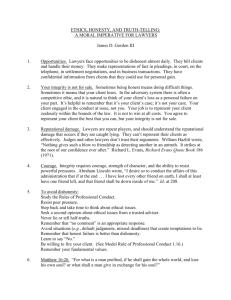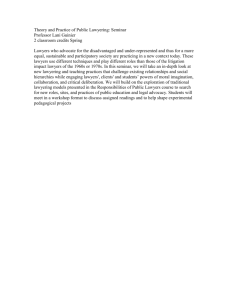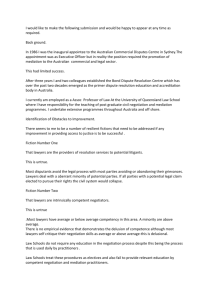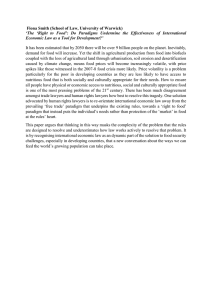Case of Casey Klein and Robin Vega - Overview John Lande
advertisement
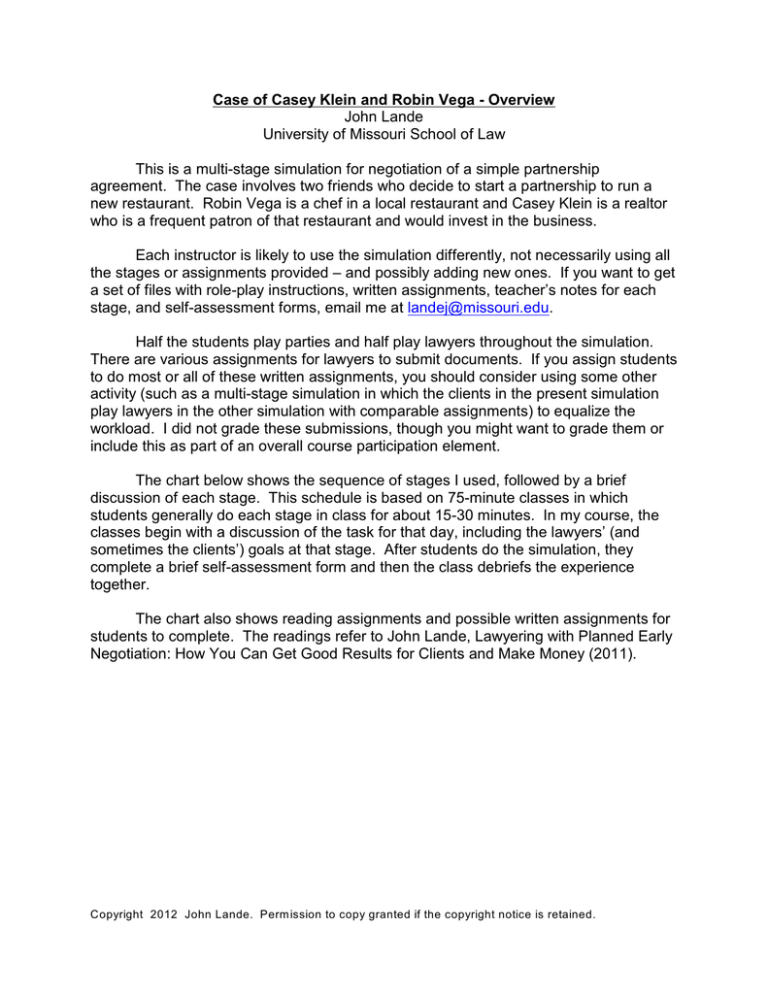
Case of Casey Klein and Robin Vega - Overview John Lande University of Missouri School of Law This is a multi-stage simulation for negotiation of a simple partnership agreement. The case involves two friends who decide to start a partnership to run a new restaurant. Robin Vega is a chef in a local restaurant and Casey Klein is a realtor who is a frequent patron of that restaurant and would invest in the business. Each instructor is likely to use the simulation differently, not necessarily using all the stages or assignments provided – and possibly adding new ones. If you want to get a set of files with role-play instructions, written assignments, teacher’s notes for each stage, and self-assessment forms, email me at landej@missouri.edu. Half the students play parties and half play lawyers throughout the simulation. There are various assignments for lawyers to submit documents. If you assign students to do most or all of these written assignments, you should consider using some other activity (such as a multi-stage simulation in which the clients in the present simulation play lawyers in the other simulation with comparable assignments) to equalize the workload. I did not grade these submissions, though you might want to grade them or include this as part of an overall course participation element. The chart below shows the sequence of stages I used, followed by a brief discussion of each stage. This schedule is based on 75-minute classes in which students generally do each stage in class for about 15-30 minutes. In my course, the classes begin with a discussion of the task for that day, including the lawyers’ (and sometimes the clients’) goals at that stage. After students do the simulation, they complete a brief self-assessment form and then the class debriefs the experience together. The chart also shows reading assignments and possible written assignments for students to complete. The readings refer to John Lande, Lawyering with Planned Early Negotiation: How You Can Get Good Results for Clients and Make Money (2011). Copyright 2012 John Lande. Perm ission to copy granted if the copyright notice is retained. Class Task Reading Assignment 1 Initial Client Interview Lande, ch. 2, appendixes A and B. Lawyers request information following interview 2 Negotiate Retainer Lande, ch. 3, Appendix J. 3 Plan with Counterpart John Lande, Getting Good Results for Clients by Building Good Working Relationships with “Opposing Counsel,” 33 U. La Verne L. Rev. 107 (2011). 4 Prepare Client Lande, ch. 6 5 Plan for Dispute Resolution Lande, Appendix T. CPR Model DR Clauses, http://www.cpradr.org/Resources/ ALLCPRArticles/tabid/265/ID/635/ CPR-Model-Clauses-and-Sample -Language.aspx 6 Negotiate Deal 7 Debrief Lawyers draft negotiation plan (Lawyers draft agreement) 1. The instructions for the initial client interview are similar to instructions for onestage simulations where students negotiate or mediate the ultimate resolution. In this simulation, the goal of this stage is for the lawyers to develop good relationships with their clients, elicit basic information (including the clients’ interests), and decide what additional information they need. Following this stage, lawyers submit requests to the instructor for additional information. I provided a single response to all students (i.e., on both sides and including both lawyers and clients) based on the requests submitted by the various lawyers. The simulation package includes the additional information I provided to students. I did not given specific responses to each student’s submission or grade them, though you may do so. 2. The lawyers and clients negotiate the fee provision of a retainer agreement. As described in the reading assignment, the fee arrangement can have a major impact on the lawyer-client relationship – and negotiating this issue is a daunting task for most students. Law firms are increasingly offering alternative fee arrangements, which can have a significant effect on how a matter is handled Copyright 2012 John Lande. Perm ission to copy granted if the copyright notice is retained. and the clients’ satisfaction. I have students do this in an “improv” (or “fishbowl”) format in the front of the class, though you could have each pair of students do this separately. 3. The lawyers plan the agenda and other procedural matters for the ultimate negotiation, in stage 6. While the lawyers are meeting, the parties also meet to discuss the business aspects of the deal, such as the restaurant cuisine, location, hours, etc. The parties’ discussion is important to lay the groundwork for their role in the ultimate negotiation, where they may play a larger role than parties typically do in negotiations to settle litigated disputes. Students playing lawyers get the experience in the ultimate negotiations of working with parties who take a larger role in the negotiation. 4. The lawyers meet with their clients to prepare for the negotiation. Lawyers and clients report to each other about their meetings with their counterparts during the prior class. Based on this information, they strategize about how to handle the ultimate negotiation. The lawyers are assigned to write a negotiation plan and are encouraged to start drafting the plan before this meeting to identify critical information and ideas for the planning. 5. The lawyers plan for dispute resolution in the operation of the business. The facts describe uncertainty and differences in perspectives that could easily lead to disputes in a new business. In real life, this discussion might take place as part of a planning meeting or during the ultimate negotiation itself (if at all). This topic is important and worth an entire class. Students anticipate types of disputes that may arise, plan ways to manage the disputes informally, and consider dispute resolution provisions for the partnership agreement. I used an “improv” format, beginning with conversations between two lawyers on the same side, where one student plays a senior partner and the other is the lawyer handling the case who seeks advice from the partner. After these preparatory scenes, lawyers from both sides meet to plan dispute prevention and management. 6. The entire class is devoted to the negotiation. 7. The entire class is devoted to debriefing the negotiation. You might assign pairs of lawyers to write up a simple partnership agreement. This assignment prompts students to consider what is important in writing a good agreement or release. Even if you don’t require students to draft an agreement, you can discuss drafting issues as part of the debriefing. Instructors are welcome to use or adapt the materials in this simulation. If you want to edit any of the materials, please add “adapted with permission” to the copyright notice. Copyright 2012 John Lande. Perm ission to copy granted if the copyright notice is retained. You can see my syllabus and I would be happy to discuss designing a course. The rationale for including multi-stage simulations in a negotiation course is described in my article, Teaching Students to Negotiate Like a Lawyer, 39 Washington University Journal of Law and Policy 109 (2012) and Lessons from Teaching Students to Negotiate Like a Lawyer, 15 Cardozo Journal of Conflict Resolution 1 (2013) which provide other recommendations for planning a negotiation course. Copyright 2012 John Lande. Perm ission to copy granted if the copyright notice is retained.
